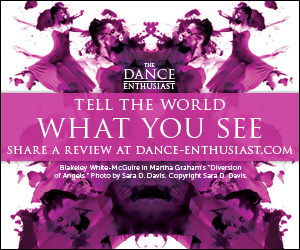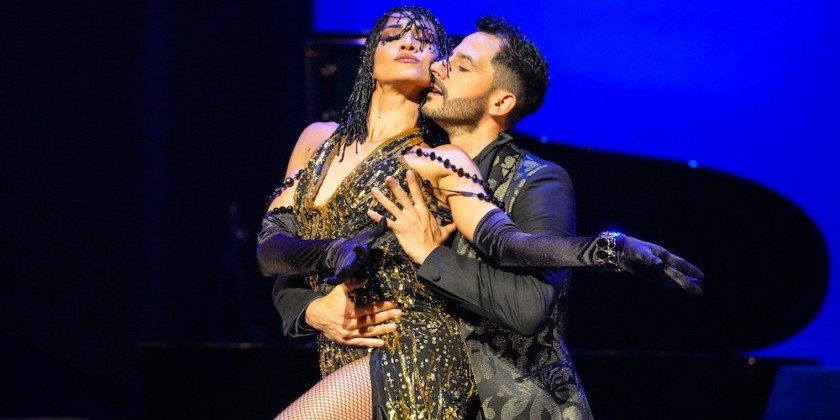AUDIENCE REVIEW: Ballet Vlaanderen’s Joyce Theater Debut: Embracing New Hybrid Forms of Creativity

Company:
Ballet Vlaanderen
Performance Date:
March 3-7 2020; Reviewed in October 2020 in reflection of today's changing dance landscape
Freeform Review:
Almost seven months ago, the trademark golden lights of The Joyce Theater marquee introduced a company taking its first steps in New York’s Chelsea: Ballet Vlaanderen. Hailed by The New York Times as “one of Europe’s top ballet companies”, the Belgian-based company’s boundary-pushing repertoire, fifteen technically-sound dancers, and impressive mixed-bill debut program suggested that ballet may not be the only thing this company is capable of.
Khan / Cherkaoui / Pite. These were the names featured in my mixed bill program book for Ballet Vlaanderen’s series of performances from March 3-7. A tableau of creativity that would send chills up the arms of any European contemporary dance enthusiast. How would an institution like Ballet Vlaanderen, historically known as a predominantly balletic company, tackle the works of some of the leading pillars in today’s contemporary dance world?
Murmurs of anticipation trickled into the theatre. Winter coats shuffled about. Audiences puzzle-pieced themselves into their tightly packed seats. Hugs and kisses were exchanged. The air was charged with a collective held-in-breath, waiting for the curtain to be lifted. This intimacy now seems almost surreal since COVID-19 made its entr’acte into the world. Yet this was the atmosphere for Joyce Theater audiences’ introduction to Ballet Vlaanderen’s hybrid identity, starting with Akram Khan’s Kaash.
A soloist with a bare, exposed back stood silently before Anish Kapoor’s set design, muscles rippling as if ready to spring. His first swirling, sinuous motion sent the stage pulsing into movement, with fourteen dancers cutting through the space with calculated precision and simultaneous circularity. Wrists arched, the dancers’ arms resembled birdlike appendages or hooked swan necks – a thematic element that reemerged throughout the piece in visually-impressive cannons or flocking movements that sent dancers flying through the space.
British-Bengali dancer-choreographer Akram Khan’s revival of his 2002-work Kaash, (meaning “if only” in Hindi) presents his vision of Shiva - the god of both destruction and creation - and the cyclical nature of life and death. This cyclical nature is reflected in the choreography’s circular ebb and flow, punctuated by percussive stops in motion to Nitin Sawhney’s original score. The choreographer’s unique hybrid movement language blends contemporary dance with the Indian classical dance form Kathak. In The Guardian writer Maya Jaggi’s “A life in dance: Akram Khan”, Khan explains of his merging of dance forms that “classical (kathak) is me in search of the spiritual, and contemporary is me searching for science, destroying and taking things apart”.
It is interesting to see the blended movement language of Khan translated by dancers of a company also navigating a hybrid of dance styles – namely, that of the contemporary and ballet worlds. Ballet Vlaanderen was founded by Belgian dancer-choreographer Jeanne Brabants in 1969 and despite celebrating 50 years of existence, it has been deemed a company in search of its identity by some. The company had been in a bit of a rut for several years, so the merging of Opera Vlaanderen with Ballet Vlaanderen into Opera Ballet Vlaanderen (OBV) and the appointment of Sidi Larbi Cherkaoui in 2015 welcomed in a shift of perspective. Belgian dancer-choreographer Cherkaoui’s non-hierarchal vision that contemporary and ballet are merely extensions of each other, and his love of different art forms brings a fresh palette to Ballet Vlaanderen’s ballet tradition.
As Ballet Vlaanderen’s dancers intricately executed rhythmic patterns reminiscent of NDT’s Marco Goecke’s signature style, grounded themselves in Khan’s deep lunges, and flew through the air in crisp balletic grand cabrioles, I got a first look at how this group projected their stylistic versatility.
The program’s second piece, Faun, similarly blended contemporary and ballet, though it was the expertise of dancers Philipe Lens and Nicola Wills that entranced me most. This virtuosic duet combined traces of Cherkaoui’s signature gravity-defying Eastman movement with an ode to Vaslav Nijinski’s 1912 legendary choreography. Nijinsky’s original, controversial choreography was set to Claude Debussy’s Prèlude à l’àpres-midi d’un faune and was inspired by Grecian vases. Cherkaoui premiered his own version of the work in 2009 after being encouraged by Sadler’s Wells to draw inspiration from Ballet Russes’ repertory. Combining elements of Nijinsky’s version with his own unique movement language, partnered with Nitin Sawhney’s innovative soundtrack (a combination of his own composition and Debussy’s music), Cherkaoui’s Faun is less time-specific, and blends contemporary dance with ballet.
Dancers Philipe Lens and Nicola Wills’ expertly presented Ballet Vlaanderen’s interpretation of Cherkaoui’s work. Embodying the role of the faun, Lens floated in the movement as if a puppet on strings, moving off balance and recovering in ways that seemed almost physically impossible. Wills and Lens intertwined in an unpredictable duet that carried a simultaneous innocence and sensuality between faun and nymph. Their movement surely contrasted the typically upright posture of ballet dancers, though their technique pleasingly shone through. It was quite spellbinding to watch.
The evening concluded with Crystal Pite’s Ten Duets on the Theme of Rescue, performed by Ballet Vlaanderen’s Matt Foley, Lara Fransen, Philipe Lens, Teun van Roosmalen, and Nicola Wills. Canadian choreographer Crystal Pite’s international renown naturally brings in an audience on its own, so I was excited to see Ballet Vlaanderen tackle her work. As the dancers executed a series of duets in designer Jim French’s dreamlike maze of lighting, their winding, accentuated movement projected feelings of simultaneous isolation and connection. A standout moment was in the sixth duet: the silhouetted Lens running in desperation towards Wills, reaching for a hand that was always close but heartbreakingly out of reach.
As always, Pite’s partnering choreography works like a puzzle – each movement informing the other. With their technical prowess, Ballet Vlaanderen’s dancers managed the hybrid movement dialogue of Pite’s language, as they threw, caught, and gingerly supported each other. Ballet Vlaanderen’s capability to take on these contemporary repertory works as a traditionally balletic company will hopefully inform their next steps towards figuring out how the pieces of contemporary dance and ballet can be puzzled together.
The world has shifted quite a bit since I watched this performance in March. How is Opera Ballet Vlaanderen navigating the new COVID-19 landscape for the dance world?
After shutting down completely in March 2020 due to COVID-19, Opera Ballet Vlaanderen revealed their latest plans for the fall and 2021. Recently, Jan Vandenhouwe assumed a new position as the artistic director of both opera and ballet, allowing Cherkaoui to focus more on his artistic and choreographic role. The path Cherkaoui carved out enabled the company to embrace a new identity as a hybrid arts institution, and one of their new programs, Vonk (or “spark”) is a testament to that new perspective: a new platform to experiment with diverse, unusual art forms to expand opera and ballet into a new direction. Additionally, the company is developing new opera productions, video performances, and its fifteenth Choreolab, until it can hopefully resume live performances again in 2021.
Opera Ballet Vlaanderen’s hybrid approach to creative forms is being echoed in our dance community today. Social distancing, closed theaters/studios, and paused performances have pushed us to stretch our creativity to new levels. Internationally renowned companies like Opera Ballet Vlaanderen and individual freelance artists alike have begun blending their performative skills with another rising style: dance in the virtual world. Nonetheless, the countless dance films, livestreams, and online classes that have arisen in response to the pandemic’s restrictions only reinforce our community’s perseverance to rise and adapt to this shifting, hybrid creative landscape.
I still remember applauding loudly with my fellow audience members at the conclusion of Ballet Vlaanderen’s Joyce performance. The standing ovations and encores suggested the company’s name would soon return to The Joyce Theater marquee sign.
Though those marquee lights are temporarily dimmed today, another message rings out instead: “We Will Dance Again”. Like my inkling about Ballet Vlaanderen’s return to NYC, I can’t help but believe the marquee’s message. Yes, we will return. Maybe with a new hybrid approach to dance and the digital world. But we will be back. We will dance again. Onward.
Author:
Dominique Dobransky / Freelance Dancer, Artist, Writer
Website:
https://dominiquedobransky.com/
Photo Credit:
Dominique Dobransky











